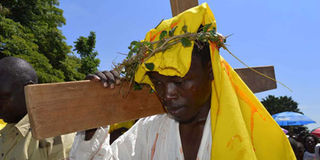Why Kenyans identify with crucifixion

Erick Muli marks Good Friday on April 14, 2017 in Kisumu by re-enacting the crucifixion of Jesus Christ. Jesus was crucified and Kenyans are mostly a crucified people. PHOTO | ONDARI OGEGA | NATION MEDIA GROUP
What you need to know:
- The Cash Transfer programme for the aged and vulnerable groups is also a step in the right direction.
- Kenya needs a more comprehensive radical plan to address endemic poverty otherwise this society will remain more unequal
There is something beautiful, raw and humbling about the Good Friday liturgy.
It attracts larger crowds than any other event in the religious calendar as the committed and quite a few curious endure the scorching sun in a walk of solidarity with the tormented man from Galilee.
The popularity of the devotion is of course also down to the fact that the betrayal, humiliation, passion and death of Jesus resonate with the vast majority of this nation’s citizens.
Jesus was crucified and Kenyans are mostly a crucified people.
POOR VS RICH
The majority can certainly identify with unjust trials, frequent failures and falls, betrayal, treachery and contempt meted out by those appointed to govern them.
This may also explain why the largest crowds of Good Friday worshippers are found in the poorer areas and the same devotion is often carried indoors in better off parishes.
The manner in which the service is carried out reflects how two worlds live and worship.
The poor live on the margins while the affluent live comfortably and secure.
THE WEALTHY FEW
The latter, of course, save their energy and cash for the Easter celebrations and may well skip the Passion on Friday.
Easter for them is a trip to the Coast, a nyama choma gathering or a weekend away in the country.
They are an Easter people, a minority who have risen through the ranks and now enjoy the benefits of education, hard work and success.
Good for them. Holidays and spare cash in your ATM card are your right.
Problem is that these rights are only enjoyed by 20 per cent of the population who earn over Sh50,000 per month.
This group enjoys the comfort of new shopping malls and superhighways and look forward to trips on the Standard Gauge Railway (SGR) train.
COST OF LIVING
They are very comfortable with the Jubilee administration and wonder why we need a change of government.
They live oblivious of what life is like for the majority.
They may even believe that wealth will soon trickle down to the marginalised who will also afford a reconditioned Japanese import.
That, of course, does not happen as Pope Francis says our system is designed to lock out the majority from meaningful participation and just enjoyment of the wealth of the earth.
Jubilee point to their successes on the new digital portal but that means nothing to the majority who know that reducing the price of unga until August is far from a solution to the rising cost of living.
PROGRESSIVE PROJECTS
Mega projects mean little or nothing to millions living a hand to mouth existence.
Efforts at overhauling NHIF have made it more accessible and beneficial to the public.
The Cash Transfer programme for the aged and vulnerable groups is also a step in the right direction.
Yet, welfare programmes alone do not address inequality or raise standards of living.
Kenya needs a more comprehensive radical plan to address endemic poverty otherwise this society will remain more unequal, more polarised and more prone to revolt.
Not a single politician has offered such a plan even though they have been campaigning since January.
While the poor continue to be crucified, the nation is in limbo heading for the general election.
[email protected] @GabrielDolan1





